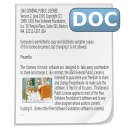Ranking of tutorials on YouTube based on the analysis of feelings made to their comments
Abstract
The flow of information arises day by day through the Internet in a continuous way thanks to the constant interactions between users, these interactions present feelings that can be positive or negative. This helps social media content creators a lot to understand how useful what they do is for their followers, and if these are a large number, an analysis done by a single person is not enough. For this, it is necessary to use tools that operate with large amounts of data, such as BERT, which is a model that helps analyze sentiments and classify comments based on what one of them expresses. In this work, this model will be used for the classification of YouTube comments and the classification of videos on this same platform, evaluating these videos according to their content and helping viewers to choose the videos if they help them concerning what is expected. find searching. This work will also use future metrics and suggestions for the proposal.
Downloads
References
Melissa Carvalho Costa Alexandre Asha de Lassance Cunha and Marco Aurelio C. Pacheco. Sentiment analysis of youtube video comments using deep neural networks. In Lecture Notes in Computer Science, pages 561–570, 2019. DOI: https://doi.org/10.1007/978-3-030-20912-4_51
Salman Aslam. Youtube by the numbers: Stats, demographics & fun facts. Omnicore, March 14, 2022, https://www.omnicoreagency.com/youtubestatistics/.
Hanif Bhuiyan, Jinat Ara, Rajon Bardhan, and Md Rashedul Islam. Retrieving youtube video by sentiment analysis on user comment. In 2017 IEEE International Conference on Signal and Image Processing Applications (ICSIPA), pages 474–478. IEEE, 2017. DOI: https://doi.org/10.1109/ICSIPA.2017.8120658
Steven Bird, Ewan Klein, and Edward Loper. Natural language processing with Python: analyzing text with the natural language toolkit. . O’Reilly Media, Inc.", 2009.
Marouane Birjali, Mohammed Kasri, and Abderrahim Beni-Hssane. A comprehensive survey on sentiment analysis: Approaches, challenges and trends. KnowledgeBased Systems, 226:107134, 2021. DOI: https://doi.org/10.1016/j.knosys.2021.107134
Tom Brown, Benjamin Mann, Nick Ryder, Melanie Subbiah, Jared D Kaplan, Prafulla Dhariwal, Arvind Neelakantan, Pranav Shyam, Girish Sastry, Amanda Askell, et al. Language models are few-shot learners. Advances in neural information processing systems, 33:1877–1901, 2020.
Navoneel Chakrabarty. A machine learning approach to comment toxicity classification. In Computational intelligence in pattern recognition, pages 183–193. Springer, 2020. DOI: https://doi.org/10.1007/978-981-13-9042-5_16
Jin Ding, Hailong Sun, Xu Wang, and Xudong Liu. Entity-level sentiment analysis of issue comments. In Proceedings of the 3rd International Workshop on Emotion Awareness in Software Engineering, pages 7–13, 2018. DOI: https://doi.org/10.1145/3194932.3194935
ENOIT DURAND. 500+ programming ytb comments. Kaggle, https://www.kaggle.com/datasets/bdok 774-programming-ytb-commentsdataset/code?resource=download.
Abbi Nizar Muhammad, Saiful Bukhori, and Priza Pandunata. Sentiment analysis of positive and negative of youtube comments using naïve bayes–support vector machine (nbsvm) classifier. In 2019 International Conference on Computer Science, Information Technology, and Electrical Engineering (ICOMITEE), pages 199–205. IEEE, 2019. DOI: https://doi.org/10.1109/ICOMITEE.2019.8920923
Adewale Obadimu, Esther Mead, Muhammad Nihal Hussain, and Nitin Agarwal. Identifying toxicity within youtube video comment. In International conference on social computing, Behavioral-cultural modeling and prediction and behavior representation
in modeling and simulation, pages 214–223. Springer, 2019.
Ayushka Tiwari Ritika Singh. Youtube comments sentiment analysis. International Journal of Scientific Research in Engineering and Management (IJSREM), 2021.
Jalaj Thanaki. Python natural language processing. Packt Publishing Ltd, 2017.
Copyright (c) 2022 Innovation and Software

This work is licensed under a Creative Commons Attribution 4.0 International License.
The authors exclusively grant the right to publish their article to the Innovation and Software Journal, which may formally edit or modify the approved text to comply with their own editorial standards and with universal grammatical standards, prior to publication; Likewise, our journal may translate the approved manuscripts into as many languages as it deems necessary and disseminates them in several countries, always giving public recognition to the author or authors of the research.
























